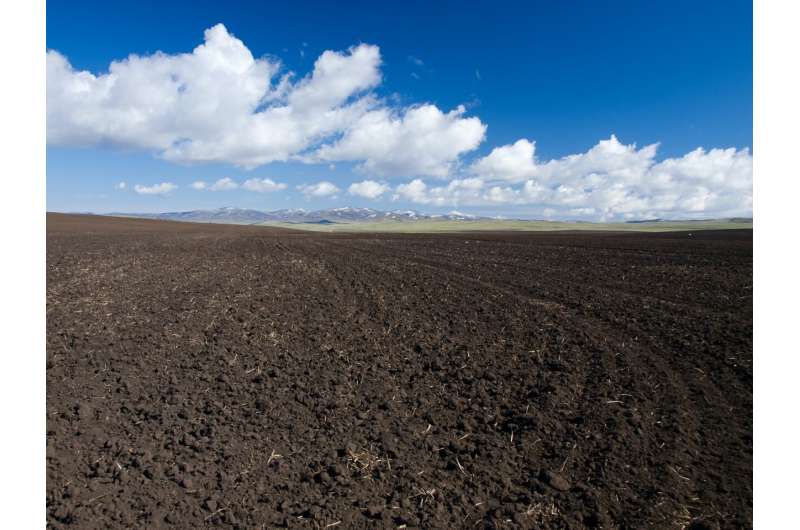Study reveals relationship between soil nitrogen stable isotope and soil water content across the globe
The natural abundance of soil nitrogen (N) stable isotope (δ15N) is a good proxy indicating the integrative soil N cycling processes and fluxes over a long time scale.
However, its spatial patterns around the globe is not well understood. In addition, the association with soil water content (SWC), which is a critical factor regulating soil N cycling process, has been little studied.
Recently, researchers led by Prof. Zhu Qing from the Nanjing Institute of Geography and Limnology of the Chinese Academy of Sciences investigated the relationship between soil δ15N and SWC at the global scale, and explored the key controls of soil δ15N in different climate zones.
This work was published in Catena.
“Based on the soil δ15N and SWC data in 910 grids of the globe, we found an upward-concave relationship between soil δ15N and SWC,” said Prof. Zhu. Higher soil δ15N existed at both the dry and wet ends of the SWC. Inconsistent relationships in five Koppen-Geiger climate zones constituted this upward-concave relationship.
The positive relationship between soil δ15N and SWC in the Tropical zone determined the increasing trend of soil δ15N at the wet end of the spectrum. It was mainly caused by the hydrologically regulated soil N losses. Increased SWC under the warm and moist condition would promote the denitrification and thus a lot of N gaseous losses as N2O and N2; it would also trigger surface runoff and subsurface flow, and thus drive dissolved and particulate N losses.
The negative relationship in the Arid zone determined the decreasing trend at the dry end of the spectrum. It was mainly caused by the increased proportions of abiotic N losses like ammonia volatilization and N supplement through bedrock weathering (higher δ15N) with the decrease of SWC under the dry, hot and infertile soil condition.
“Poor relationships between soil δ15N and SWC in the Temperate, Cold and Polar zones constituted the transition range of the upward-concave relationship [around] the globe,” said Prof. Zhu. “This suggested that not hydrologically but climatically determined low soil N losses was responsible for the low soil δ15N in these zones.”
More information:
Xiaoming Lai et al, Relationship between soil 15N natural abundance and soil water content at global scale: Patterns and implications, CATENA (2022). DOI: 10.1016/j.catena.2022.106879
Citation:
Study reveals relationship between soil nitrogen stable isotope and soil water content across the globe (2023, January 17)
retrieved 17 January 2023
from https://phys.org/news/2023-01-reveals-relationship-soil-nitrogen-stable.html
This document is subject to copyright. Apart from any fair dealing for the purpose of private study or research, no
part may be reproduced without the written permission. The content is provided for information purposes only.

The natural abundance of soil nitrogen (N) stable isotope (δ15N) is a good proxy indicating the integrative soil N cycling processes and fluxes over a long time scale.
However, its spatial patterns around the globe is not well understood. In addition, the association with soil water content (SWC), which is a critical factor regulating soil N cycling process, has been little studied.
Recently, researchers led by Prof. Zhu Qing from the Nanjing Institute of Geography and Limnology of the Chinese Academy of Sciences investigated the relationship between soil δ15N and SWC at the global scale, and explored the key controls of soil δ15N in different climate zones.
This work was published in Catena.
“Based on the soil δ15N and SWC data in 910 grids of the globe, we found an upward-concave relationship between soil δ15N and SWC,” said Prof. Zhu. Higher soil δ15N existed at both the dry and wet ends of the SWC. Inconsistent relationships in five Koppen-Geiger climate zones constituted this upward-concave relationship.
The positive relationship between soil δ15N and SWC in the Tropical zone determined the increasing trend of soil δ15N at the wet end of the spectrum. It was mainly caused by the hydrologically regulated soil N losses. Increased SWC under the warm and moist condition would promote the denitrification and thus a lot of N gaseous losses as N2O and N2; it would also trigger surface runoff and subsurface flow, and thus drive dissolved and particulate N losses.
The negative relationship in the Arid zone determined the decreasing trend at the dry end of the spectrum. It was mainly caused by the increased proportions of abiotic N losses like ammonia volatilization and N supplement through bedrock weathering (higher δ15N) with the decrease of SWC under the dry, hot and infertile soil condition.
“Poor relationships between soil δ15N and SWC in the Temperate, Cold and Polar zones constituted the transition range of the upward-concave relationship [around] the globe,” said Prof. Zhu. “This suggested that not hydrologically but climatically determined low soil N losses was responsible for the low soil δ15N in these zones.”
More information:
Xiaoming Lai et al, Relationship between soil 15N natural abundance and soil water content at global scale: Patterns and implications, CATENA (2022). DOI: 10.1016/j.catena.2022.106879
Citation:
Study reveals relationship between soil nitrogen stable isotope and soil water content across the globe (2023, January 17)
retrieved 17 January 2023
from https://phys.org/news/2023-01-reveals-relationship-soil-nitrogen-stable.html
This document is subject to copyright. Apart from any fair dealing for the purpose of private study or research, no
part may be reproduced without the written permission. The content is provided for information purposes only.
